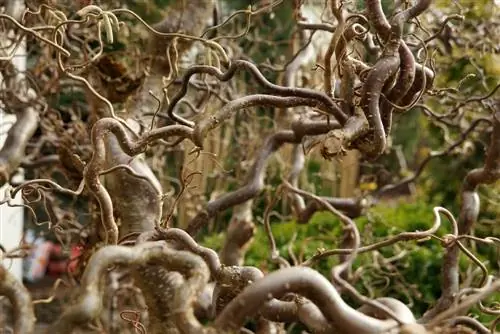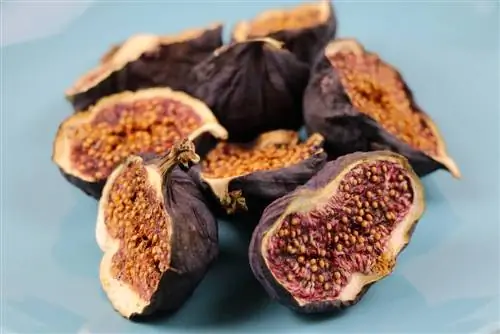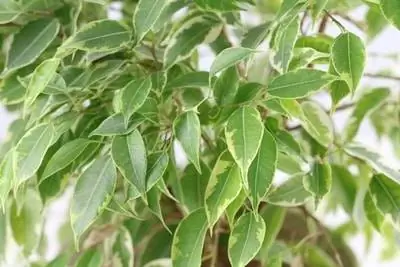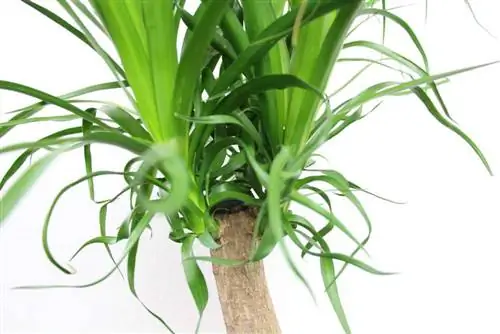- Author admin [email protected].
- Public 2023-12-17 03:39.
- Last modified 2025-01-24 12:45.
A shiny green foliage, coupled with modest requirements, has catapulted the birch fig into the Olympus of most popular houseplants. Nevertheless, the rapid growth causes headaches when the tropical plant expresses its desire to become a majestic tree. Home gardeners counteract this with targeted pruning, even if the crown already touches the ceiling. These instructions explain how to properly cut and skillfully rejuvenate Ficus benjamini.
The best time
If you see the need for a topiary cut on your birch fig, you can always take out the scissors. The exotic ornamental tree is well tolerated by pruning. So don't spend too much time dealing with one or two annoying branches, just cut them back as soon as possible. However, if you are considering extensive topiary or would like to rejuvenate Ficus benjamini, an appointment in late winter or early spring is mandatory. The reason for this recommendation is the limited growth dormancy during the winter due to the lack of light.
Since your indoor tree reacts to every cut with a shoot, scissors should not be used between November and February. The result would be stunted, weak branches. However, if you choose a date shortly before the start of the new growing season in March or April, this caution will be rewarded with vital, bushy, compact growth and leaf shoots.
Tip:
Shedding leaves is not a reason to prune your birch fig. Rather, the plant signals problems in the location or in care. Abrupt temperature changes, lack of light, drought stress or waterlogging are the most common causes. Once these triggers have been resolved, a Ficus benjamini will put its foliage back on.
Preparatory work
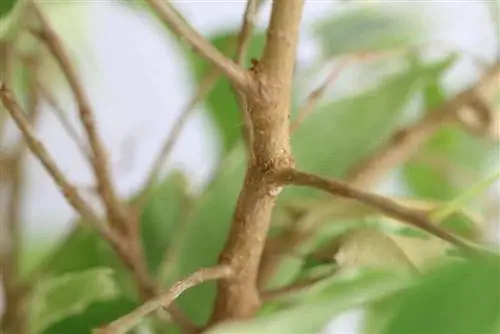
In its habitats along the tropical belt, the birch fig defends itself against predators with a poisonous plant sap. This milky liquid is not harmless to the gardener. Direct skin contact can trigger allergic reactions, which in the worst case result in anaphylactic shock in latex allergy sufferers. The pruning of the birch fig ends badly if dull, dirty pruning tools are used. The following preparations focus on protecting against unpleasant consequences for gardeners and plants alike:
- Always wear gloves and long-sleeved clothing when cutting
- Sharpen the cutting blades of scissors and folding saws
- Disinfect with spirit, alcohol or hot water
To control the flow of juice on cuts, tear an absorbent kitchen fleece or temporary tissue into small pieces. You will later place these pieces on bleeding wounds. This way, sticky drops cannot contaminate the leaves or the floor. If there is warm, dry weather with temperatures above 18 degrees Celsius at the time of pruning, take Ficus benjamini outside. The garden is the best place to prevent sticky stains on the floor or carpet in the house. It is important to ensure that no bright rays of sunlight hit the fresh, bleeding cuts.
Tip:
The gray-brown trunk bark of a birch fig is smooth when young. On older trees, the bark may peel off in places. Scale insects use such damaged areas as welcome hiding places and should therefore be inspected regularly for an infestation by the pests.
Cutting guide
So that your birch fig can be harmoniously integrated into the living room design and shine in its former glory, it is important to cut it correctly. Do not place the scissors just anywhere, but rather look specifically for points of vegetation, such as leaves, buds or sleeping eyes. The plant tissue for cell division and growth is concentrated there, so a cut at this point accelerates the subsequent sprouting. How to cut a birch fig correctly:
- Short branches that are out of shape to the desired length
- Make each cut 2-3 mm above a point of vegetation
- Cover bleeding cuts immediately with a piece of fleece
- Cut back dead branches to the base
- Cut back branches growing inside the plant except for an outward-facing bud
Regular thinning out of dead branches contributes significantly to a densely leafed Ficus benjamini. It must be ensured that light can penetrate deep into the interior of the bush or crown so that photosynthesis and growth can take place there. It is not always clear at first glance whether a branch is still alive or not. A vitality test dispels any remaining doubts. Use the knife to scrape off a small piece of bark. If fresh green tissue appears underneath, the shoot can stop. Brownish-dry tissue indicates that this branch is hopelessly lost and can be removed.
Instructions for the rejuvenation cut
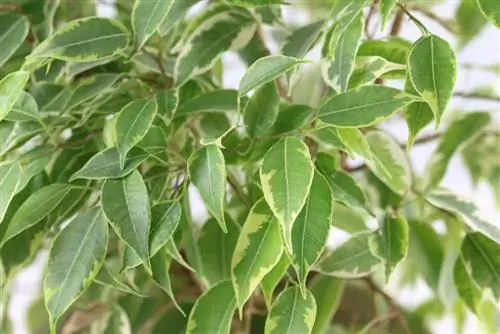
With a radical cut, the wheel of time can be turned back on an old and bare birch fig. You benefit from the fact that the indoor tree will continue to sprout again even after a cut into the old wood. A morbid appearance is therefore no reason to dispose of a formerly elegant, shapely tree or shrub.
How to properly rejuvenate Ficus benjamini:
- Thoroughly thin out the entrance to the shrub or crown
- Cut off dead wood, weak, diseased and too closely spaced shoots at the base
- Prune remaining branches by a maximum of two thirds
A rejuvenation cut always includes the roots. Therefore, pot up the birch fig after cutting the branches. Shake or rinse off the old soil. Now subject the root strands to a close inspection. Cut out dried, dead roots with sharp, disinfected scissors. Clean the pot thoroughly with hot water before repotting your Ficus benjamini.
Drainage made from pottery shards prevents harmful waterlogging. As a substrate, we recommend a peat-free potting soil with a pH value of 6.0 to 6.8, enriched with a handful of lava granules or perlite respiration flakes. If you use a new bucket, it shouldn't be too big. A birch fig sprouts more compactly and bushily if the volume in the container is slightly restricted. The distance between the edge of the pot and the root ball should not be more than two fingers' width.


